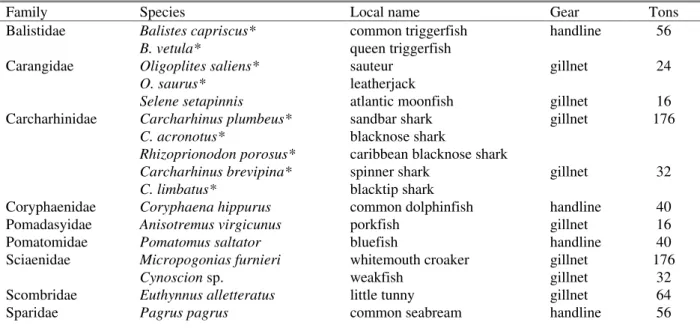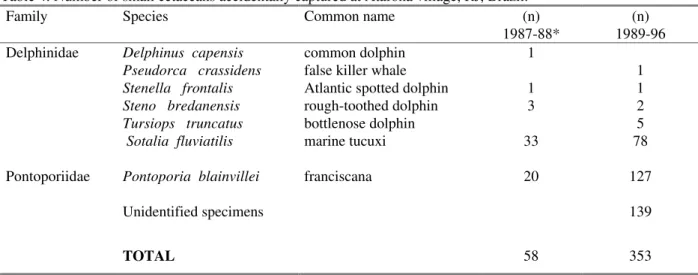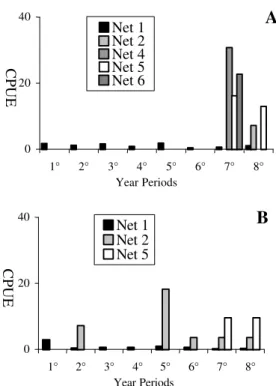Fishing Activity in Northern Rio de Janeiro State (Brazil)
and its Relation with Small Cetaceans
Ana Paula Madeira Di Beneditto*, Renata Maria Arruda Ramos and Neuza Rejane Wille Lima Universidade Estadual do Norte Fluminense, Centro de Biociências e Biotecnologia, Laboratório de Ciências Ambientais. Av. Alberto Lamego, 2000, Campos, RJ, 28015-620, BRASIL
ABSTRACT
Research on fishing activity at Atafona village, in Northern Rio de Janeiro, Brazil (21°35’S), was carried out between 1987-96 for the purpose of relating it to the accidental capture of small cetaceans and of estimating the relationship between fishing activity and the diet of small cetaceans. Data on fishing operations were obtained at the cold storage plants management, from interviews with fishermen and personal observations. The most representative fishing resources were Xyphopenaeus kroyeri,
Micropogonias furnieri, Carcharhinus plumbeus, C. acronotus, and Rhizoprionodon porosus. Gillnets are responsible for the accidental capture of small cetaceans in the region, mainly Pontoporia blainvillei
and Sotalia fluviatilis (marine form). Four types of gillnets that are used on the region (“minjuada”, “sarda”, “caçoá” and “pescadinha”) were dangerous to these species because they are placed in their preferred habitat. There is no competition between fishermen and small cetaceans due to the selection in the capture of commercialized fishes
Key words: Fishery, Accidental capture, Pontoporia blainvillei, Sotalia fluviatilis
*
Author for correspondence
INTRODUCTION
The coast-line of Rio de Janeiro State is 636 Km long and represent the third longest shore; the second in diversity of bays, estuaries and lagoons; and the third largest fish producer in Brazil. In this context, Atafona village (Fig.1) represents 5% of the annual fishing activity of the State, been one of the most representative fishing harbours in terms of gillnet use (IBAMA, unpublished data). The gillnets are responsible for the accidental capture of small cetaceans and studies on the local relationship between dolphins and fishing activity were first conducted by Lodi & Capistrano (1990).
The purpose of this paper is to describe the fishing activity at Atafona village, in order to relate its impact on the species of small cetaceans and to estimate the relationship between fishing activity and the diet of the most captured species.
MATERIALS AND METHODS
the sea, with both ends fixed by anchors, or with one of them fixed in the boat. The gillnet can be positioned near the surface or the bottom, according to weather conditions or the position of the catch target. At Atafona village six kinds of gillnet are used, as shown in Table 1.
The gillnet, locally called as “caída”, is the preferred net type and has been in use for more than 20 years at Atafona village (Table 1). Each net has 25 small rounded floats, measuring 8 cm in diameter attached to an upper frameline, and 24 leads, weighing 200 g on a lower frameline. When the net is placed near the bottom, there is a stone of 8×8×8 cm attached for every eight leads, totalling three stones per net. Along the line of nets there are floats of 30×24×24 cm for every six nets. The nets are deployed at sea in late afternoon and removed the next morning. The soaking time is around 12 h. The boats which use the net type 1 (“caída”) operate from within one to 60 nm off-shore, in depths ranging from 6 to 70 m.
Fig. 1. Rio de Janeiro State, Southeastern Brazil.
The fishermen who use other types of gillnet, known as “caçoá”, “caçoá de plástico”, “pescadinha”, “sarda” and “minjuada”, usually work at no greater distance from shore than 3 nm and from Atafona to Açu (Fig.1; Table 1). These nets are always placed near the bottom and the soaking time is around 12 h.
Table 1. Description of gillnets used at Atafona village, RJ, Brazil.
Net type * 1 2 3 4 5 6
Length (m) 110 32 32 53 36 120
Nº per boat 20-22 40 2 25 60 30
Length of fleet (km) 2.20- 2.42 1.28 0.06 1.33 2.16 3.30
Height (m) 5.6 3.1 3.4 1.8 2.7 4.8
Mesh size (cm) 14.0 16.5 18.0 6.5 12.0 10.0
Twine material** Ny Po Ny Ny Ny Ny
Twine diameter (mm) 0.7 1.5 1.2 0.5 0.6 0.5
Nº of boats 52 3 1 1 3 2
Fishing period (nºdays)
Jan-Dec (192)
Dec-May (144)
Oct-Apr (168)
Oct-Dec (48)
Apr-Jul (96)
Nov-Mar (80)
* Local name: 1 =“caída”; 2 =“caçoá”; 3 =“caçoá de plástico”; 4 =“pescadinha”; 5 =“minjuada”; 6 =“sarda”; ** Twine material: Ny =Nylon; Po =Polypropylene.
The longlining for large sharks is used on a small scale, sometimes using fat tissue of small cetacean or musculature of the fish Euthynnus alletteratus as bait in this fishing. The longline is a polypropylene line 5 mm thick and 170 m in length, to which are fixed 10 hooks of 10 cm in length and 1.2 inches thickness. Both ends of the longline can be attached to anchors, or one of them can be attached to an anchor and the other to the boat.
Annual mortality by species caught were obtained for the years 1987-88 (Lodi & Capistrano, 1990) and 1989-96. Catch per unit effort (CPUE) data by year were calculated considering the absolute number of small cetaceans captured and total gillnet fishing effort; and the absolute number of P. blainvillei
and S. fluviatilis (marine form) and fishing effort of gillnets responsible for their entanglement.
The fishing effort unit used was the relation between the number of boats×day of active fishing operations×gillnet extention (Km). As the gillnets’ soaking time per day is around 12 h, it was considered that each two days of active fishing operations represent a whole day.
RESULTS
About 800 t of fish/year were caught from 1989 to 1991. Twelve species, of the more common fishes, captured in net type 1 (“caída”) represent 67% of annual catch, and five species captured by handline correspond to 24% (Table 2). Another 56 species of fish, including bone fishes and sharks, represent 9% of the annual catch. The mesh size of these gillnet is selective in relation to the size of the target species, whose mean standard length varies from 40 to 80 cm. The bone fishes are marketed whole, with head and tail, and in natura, kept fresh on ice. On the other hand, the sharks are marketed without head and eviscerated.
Table 2. Mean annual quantity of bone fish and shark species catch between 1989 and 1991 at Atafona village, RJ, Brazil.
Family Species Local name Gear Tons
Balistidae Balistes capriscus* B. vetula*
common triggerfish queen triggerfish
handline 56
Carangidae Oligoplites saliens* O. saurus*
sauteur leatherjack
gillnet 24
Selene setapinnis atlantic moonfish gillnet 16
Carcharhinidae Carcharhinus plumbeus* C. acronotus*
Rhizoprionodon porosus*
sandbar shark blacknose shark
caribbean blacknose shark
gillnet 176
Carcharhinus brevipina* C. limbatus*
spinner shark blacktip shark
gillnet 32
Coryphaenidae Coryphaena hippurus common dolphinfish handline 40 Pomadasyidae Anisotremus virgicunus porkfish gillnet 16 Pomatomidae Pomatomus saltator bluefish handline 40 Sciaenidae Micropogonias furnieri whitemouth croaker gillnet 176
Cynoscion sp. weakfish gillnet 32
Scombridae Euthynnus alletteratus little tunny gillnet 64 Sparidae Pagrus pagrus common seabream handline 56
Table 3. Mean annual quantity of shrimp species captured between 1991 and 1992 at Atafona village, RJ, Brazil.
Family Species Tons
Hippolytidae Hyppolysmata oplophoroides 17.5
Palaemonidae Nematopalaemon shmitti 23.0
Artemesia longinaris 13.5
Penaeidae Penaeus schimitti 4.5
Pleoticus mulleri 13.5
Xyphopenaeus kroyeri 828.0
Shrimp fishing with bottom trawl nets is common at Atafona village and the total catch between 1991 and 1992 was around 900 t/year. The Atlantic seabob Xyphopenaeus kroyeri
represented 92% of the annual quantity of shrimp captured (Table 3).
The accidental capture of 58 specimens of small cetaceans in gillnets were first reported at the fishing grounds in Atafona village between 1987-88 by Lodi & Capistrano (1990). The analysis conducted by the present study (1989-96) added more 353 specimens to this list (Table 4). Among the various species of dolphins captured from 1987 up to 1996, the species P. blainvillei and S. fluviatilis represent more than 95% of the total caught in the region (Table 4). These small cetaceans are entangled in gillnets by the rostrum and fins and the rescue of the
dolphins alive is difficult because of net dimensions and soaking time. In general, the accidental capture of both species happens in gillnets usually placed at a distance less than 5 nm off-shore and in depths shallower than 20 m.
The fat tissue of dolphins accidentally captured in the region can be used as bait in longline fishing to catch large sharks. Each dolphin provides around 40 to 80 pieces of bait, according to its length. The fat tissue is used fresh or salted, and is cut in rectangular pieces of 8×12 cm. The longline is used on a small scale from July to October, and the boats usually place it from 10 to 15 nm off-shore, between Atafona and Barra do Furado (Fig. 1) with a soaking time of 12 h. The principal gain in this kind of fishing is related to the size of the shark’s fins, which have a high commercial value.
Besides shrimp, during the trawl, some species of fish are also caught, but most of them have an average standard length smaller than 20 cm and/or do not have any commercial value. In general, these fishes are associated with mud and/or sand bottoms, and some species have already been identified as food for these coastal dolphins in other areas (Pinedo, 1982; Borobia & Barros, 1989).
Table 4. Number of small cetaceans accidentally captured at Atafona village, RJ, Brazil. Family Species Common name (n)
1987-88*
(n) 1989-96 Delphinidae Delphinus capensis common dolphin 1
Pseudorca crassidens false killer whale 1
Stenella frontalis Atlantic spotted dolphin 1 1
Steno bredanensis rough-toothed dolphin 3 2
Tursiops truncatus bottlenose dolphin 5
Sotalia fluviatilis marine tucuxi 33 78
Pontoporiidae Pontoporia blainvillei franciscana 20 127
Unidentified specimens 139
TOTAL 58 353
The fishing effort was constant for each net type throughout the years (Table 5). The net type 1 (“caída”) represents 93% of the effort applied in the studied area. More over, this net has been used during 23 years.
The annual CPUE values (×1,000) for small cetaceans vary from 2,7 to 7,7 small cetaceans/ fishing effort, and the mean value is 4,1 (Fig. 2). The annual CPUE values (×1,000) for P. blainvillei and S. fluviatilis in gillnets responsible for their entanglement are shown in Fig. 3. The accidental capture of P. blainvillei
and S. fluviatilis in the net type 1 (“caída”) was recorded during all years, however its CPUE value was considerably lower in comparison to the other types of gillnet.
0 5 10
1º 2º 3º 4º 5º 6º 7º 8º
CPUE
Year Periods
Fig. 2. Catch per unit effort (CPUE) (× 1,000) for small cetaceans observed during eight year periods. The periods were defined as: (1°) Jun/87 to May/88; (2°) Sep/89 to Aug/90; (3°) Set/90 to Aug/91; ... (8°) Sep/95 to Ago/96.
Table 5. Annual fishing effort for each net type at Atafona village, RJ, Brazil (1987-96).
Net type Local name Effort (km of net) 1 “caída” 11,532 2 “caçoá” 277 3 “caçoá de plástico” 5 4 “pescadinha” 32 5 “minjuada” 311 6 “sarda” 264
0 20 40
1° 2° 3° 4° 5° 6° 7° 8°
Net 1 Net 2 Net 4 Net 5 Net 6
CPUE
Year Periods
A
0 20 40
1° 2° 3° 4° 5° 6° 7° 8°
Net 1 Net 2 Net 5
CPUE
Year Periods
B
Fig. 3. Catch per unit effort (CPUE) (× 1,000) for (A) Pontoporia blainvillei in five net types and (B)
Sotalia fluviatilis in three net types observed during eight year periods. The periods were defined as: (1°) Jun/87 to May/88; (2°) Sep/89 to Aug/90; (3°) Set/90 to Aug/91; ... (8°) Sep/95 to Ago/96. Net types were defined in Table I.
DISCUSSION
The accidental capture of P. blainvillei and S. fluviatilis in net types 2, 4, 5 and 6, locally called as “caçoá”, “pescadinha”, “minjuada” and “sarda”, respectively, was observed mainly during the last four years of period studied. These gillnets are used on a small scale, but cause a greater impact on both species than net type 1 (“caída’). The first ones, always work at no greater distance from shore than 3 nm, in the preferred habitat of P. blainvillei and S. fluviatilis. Since the fishing activity, including the geographical position of the nets and the fishing effort, were constant throughout the years, such result might be related to changes in dolphins’ movement along the study area.
The annual CPUE value in the study area, is extremely low when compared with small fishing grounds in Argentine waters (Corcuera, 1994). At Monte Hermoso village (39°), for instance the CPUE for P. blainvillei in 1993 was 65 times higher than the CPUE at Atafona village. However, the annual fishing effort at Monte Hermoso was 70 times lower than at Atafona.
On the Southern Atlantic coast (32°-41°S), the coastal fishing grounds are also more dangerous to P. blainvillei than the deep-sea ones (Praderi
et al., 1989; Corcuera, 1994). Mortality levels of this species seem to be extremely sensitive to qualitative changes in coastal fishing effort, particulary the geographical position of the nets (Corcuera, 1994). S. fluviatilis also has coastal habits, and these fishing grounds is a menace to it as well.
The small cetaceans seem not to affect the local fishing activity itself. First of all, the more used gillnet (net type 1) has large mesh (14 cm between opposite knots), which is probably selective of fish larger than the potential prey species of dolphins. Second of all, the species that are collected in bottom trawl net fishing and can belong to the diet of P. blainvillei
and S. fluviatilis, do not have any regional commercial value. Thus, the results of this study suggest that there is no competition among the dolphins and the fishermen. However, the analysis of food habits of the dolphins on the study area will be important to confirm this
hypotesis. The accidental capture of small cetaceans in the studied area might be minimized through changes in coastal fishing effort.
ACKNOWLEDGEMENTS
We would like to express our deepest gratitude to the fishermen and all those involved in the fishing activity at Atafona village who provided us with information and specimens for taxonomical identification and to Petróleo Brasileiro S/A-PETROBRAS for financial support. A.P.M. Di Beneditto and R.M.A. Ramos acknowledge the fellowship support from FENORTE. N.R.W. Lima acknowledges the fellowship support from CNPq (Proc. nº 352085/96-7).
RESUMO
Investigação sobre a atividade pesqueira na localidade de Atafona, Norte do Rio de Janeiro, Brasil (21º25`S), foi conduzida entre 1987-96 com o objetivo de relacioná-la com a captura acidental e a dieta dos pequenos cetáceos. Dados sobre as operações pesqueiras foram obtidos na administração dos entrepostos de pesca, através de entrevistas com pescadores e observações pessoais. Os recursos pesqueiros mais representativos foram Xyphopenaeus kroyeri, Micropogonias furnieri, Carcharhinus plumbeus, C. acronotus, and Rhizoprionodon porosus. As redes de espera são responsáveis pela captura acidental de pequenos cetáceos na região, principalmente de Pontoporia blainvillei
REFERENCES
Borobia, M. & Barros, N.B. (1989), Notes on the diet of marine Sotalia fluviatilis. Mar. Mammal Sci.,5(4), 395-399.
Corcuera, J. (1994), Incidental mortality of franciscanas in Argentine waters: the threat of small fishing camps. Rep. Int. Whal. Commn.,15, 291-294.
Di Beneditto, A P.; Capistrano, L. & Ramos, R. (1990), Captura acidental de pequenos cetáceos na costa dos Estados do Rio de Janeiro, Espírito Santo e Bahia, Brasil. Paper presented at 4ª Reunion de Trabajos de Especialistas en Mamíferos Acuáticos de América del Sur, 12-15 November, Valdivia. Lodi, L. & Capistrano, L. (1990), Capturas acidentais de pequenos cetáceos no litoral Norte do Estado do Rio de Janeiro.
Biotemas, 3(1), 47-65.
Pinedo, M.C. (1982), Análise dos conteúdos estomacais de Pontoporia blainvillei
(Gervais & D’Orbigny, 1844) e Tursiops
gephyreus (Lahille, 1908) (Cetacea,
Platanistidae e Delphinidae) na zona estuarial e costeira de Rio Grande, RS, Brasil. MSc Thesis, Universidade do Rio Grande, Rio Grande, Brasil.
Praderi, R.; Pinedo, M.C. & Crespo, E.A (1989), Conservation and management of Pontoporia blainvillei in Uruguay, Brazil and Argentina.
In- Biology and conservation of river
dolphins, eds. W.F. Perrin; R.B. Brownell; Z. Kaiya & L. Jiankang. Occasional Papers-IUCN-SSC, Hong Kong, pp.52-56.
Secchi, E.R.; Zerbini, NA.; Möller, L.; Dalla Rosa, L. & Bassoi, M. (1994), Incidental captures of franciscana, Pontoporia blainvillei (Cetacea, Pontoporiidae), in coastal gillnet fisheries along Southern Rio Grande do Sul State, Brazil: evaluation of the problem. Final Report,UNEP, 13p.



